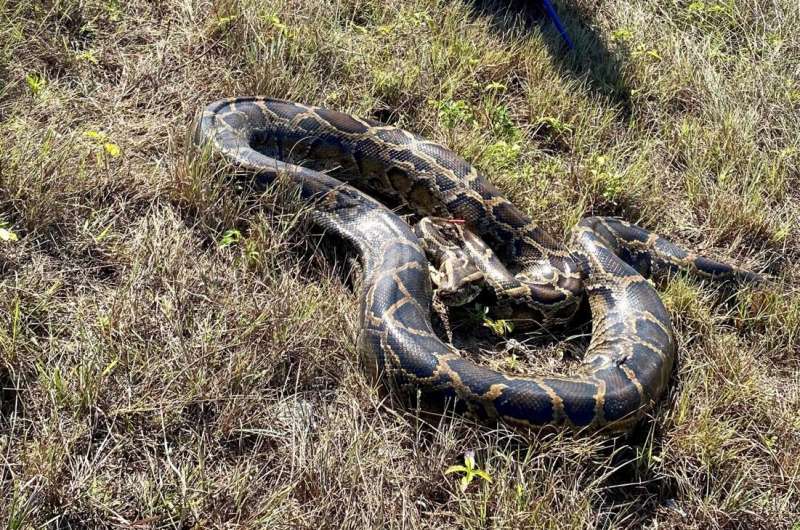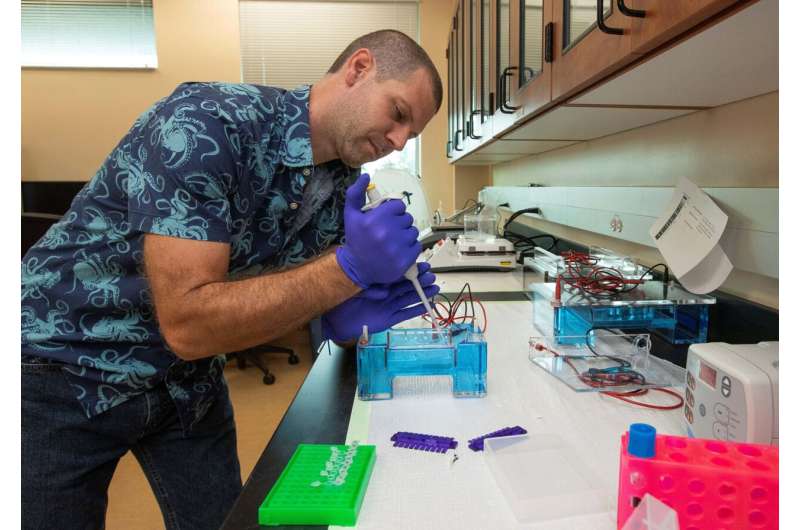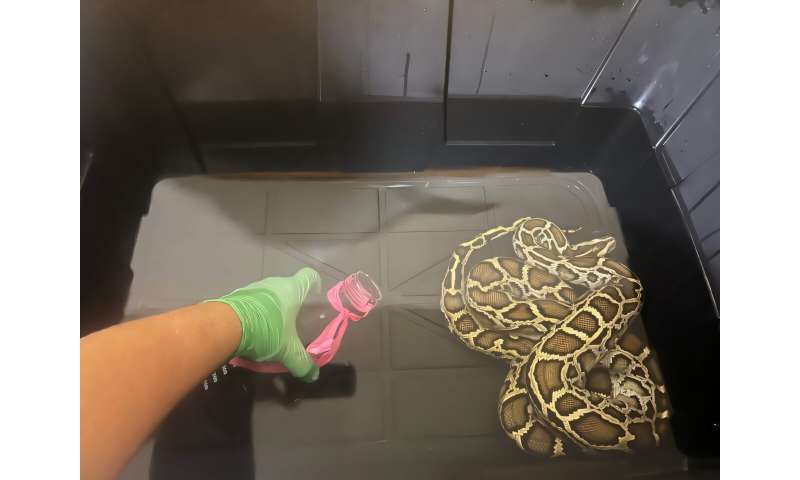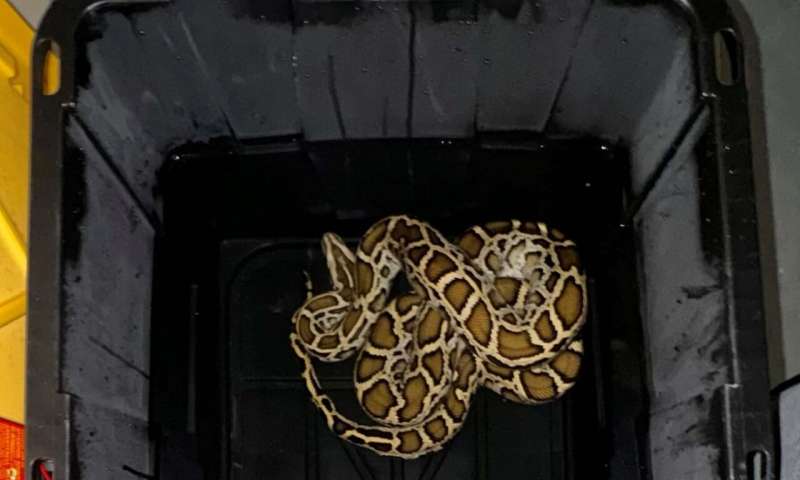This article has been reviewed according to Science X's editorial process and policies. Editors have highlighted the following attributes while ensuring the content's credibility:
fact-checked
peer-reviewed publication
trusted source
proofread
Scientists develop method 'tetraplex digital PCR assay' for detecting DNA of invasive snakes in Florida

Scientists at the University of Florida have developed a pioneering tool to bolster Florida's defenses against invasive species: a DNA-based environmental monitoring test that can pinpoint where they've been, aiding eradication efforts.
Once a nonnative species gets into an environment, it is often too late to get rid of it, and the focus shifts to containment or long-term management. Both approaches come with heavy costs concerning native wildlife and funding, explained Melissa Miller, lead author on the study and an invasion ecologist at the UF/IFAS Fort Lauderdale Research and Education Center (UF/IFAS FLREC).
"We hope this novel eDNA sampling tool we have designed will help increase efficiency in invasive species management, allowing for early detection and rapid removal of nonnative species," she said.
Known as a tetraplex digital PCR assay, this method of testing allows researchers to use water or soil samples for rapid and precise identification of Burmese pythons, northern African pythons, boa constrictors and rainbow boas from environmental DNA—which scientists refer to as eDNA—collected in the wild. The test can identify four invasive snake species simultaneously.
That eDNA refers to genetic material shed by organisms into their surroundings. Published in the journal of Ecology and Evolution, scientists at UF's Institute of Food and Agricultural Sciences (UF/IFAS) tout this as a significant advancement in detecting invasive snakes and a strategic tool for protecting Florida's ecosystems.
"Cryptic species, like most snakes, are problematic when introduced outside of their range, as detectability is low, even in high densities. With this new method, we increase our ability to detect these cryptic species tremendously, no matter how many there are," said Sergio Balaguera-Reina, co-author and research assistant scientist at the UF/IFAS FLREC.

Florida is home to over 500 nonnative species, with reptiles leading the way. More than 50 nonnative reptile species are now established across the state, with many posing severe threats to agriculture, native ecosystems, public safety and the state's economy.
Current monitoring methods depend on visual surveys by scientists, which often fail to detect invasive constrictors because they're elusive and cryptic. Traditional survey techniques are estimated to identify less than 5% of Burmese pythons. In contrast, the newly developed tetraplex assay by UF/IFAS scientists can identify DNA traces of these snakes even weeks after they have left an area.
This breakthrough offers wildlife managers a crucial tool to verify the presence of these hidden species and assess the success of removal efforts.
"While eDNA sampling has been applied to detect non-native wildlife, the benefit of our methodology is that we can now sample for numerous target species within a single sample. This can aid natural resource managers by reducing costs required to survey for non-native species in multi-invaded ecosystems," Miller said.
"With the high accuracy and specificity of this testing for detecting invasive constrictor snakes, resource managers can implement effective management strategies, such as removal efforts, quickly and with confidence."
The test was designed to operate seamlessly in Florida's varied and challenging environments, from dense Everglades habitats to urban areas where non-native constrictors are now found. With this DNA-based approach, wildlife managers can implement programs that monitor multiple species, prioritize response efforts and ultimately mitigate the ecological impacts of these snakes on Florida's ecosystems and Everglades restoration efforts.
-

This Burmese python was submerged in a bin filled with water to simulate the aquatic environment where pythons typically inhabit. Then, researchers pulled several water samples to establish the eDNA analysis. Credit: Analise Fussell. -

A Burmese python is submerged for eDNA analysis. Credit: Analise Fussell
Developing this tool required considerable work and significant technical advancements to ensure each target snake species' DNA is precisely identified.
"The initial stage was designing the molecular test, which is essentially four tests in one," said Brian Bahder, a senior author who developed the eDNA methodology and an associate professor of vector entomology at UF/IFAS FLREC.
"Each test is specific to a different snake species and was designed to detect DNA from the Burmese python, northern African rock python, rainbow boa and boa constrictor, ensuring no cross-detection among species."
Bahder, whose expertise traditionally involves detecting lethal bronzing in palm trees, explained that the fundamental process of molecular testing is similar across different organisms, with the main difference being the DNA sequence. This makes many of the techniques easily transferable.
Once the researchers successfully got the molecular test working, they conducted controlled experiments using known concentrations of DNA placed in water. They then used a vacuum pump to concentrate the DNA on a filter, which they tested to confirm that they could extract DNA from the samples and obtain accurate results.
Following this, they conducted an experiment by placing a Burmese python in water and taking water samples at different time intervals to demonstrate the method's effectiveness. The data estimated the amount of snake DNA present in the water if sampled nearby. A field experiment also showed that snake DNA could be detected in soil where a snake had been resting up to two weeks after its removal.
"These concentration estimates are the first steps in a larger monitoring effort, with further experimentation needed to determine the effects of time, distance and environmental factors on DNA detection rates," said Bahder. "Ultimately, this technology will be used to monitor and locate these invasive snakes, thereby validating removal efforts."
The new assay aligns with ongoing efforts by state and federal agencies, which have invested more than $10 million from 2004 to 2021 to manage the Burmese pythons alone.
"Successful detection and monitoring programs for invasive wildlife hinge on rapid detection and accurate identification of nonnative species," said Miller.
The UF team plans to explore the tool's potential further, by expanding the assay to include additional invasive species and applications for monitoring ecological restoration outcomes.
"There are two important next steps for harnessing the power of this eDNA analysis. First, we plan on adding additional species that can be identified using the tetraplex digital PCR assay, especially fish such as Asian swamp eels and bullseye snakeheads," said Frank Mazzotti, co-author and professor of wildlife ecology at UF/IFAS FLREC.
"Second, to fully take advantage of this new methodology, we plan on implementing a regional multi-species sampling network with the purpose of early detection for rapid response to new invasions and evaluating success of removal efforts on existing invasions in the Comprehensive Everglades Restoration Plan footprint."
More information: Melissa A. Miller et al, Development of a Tetraplex Digital PCR Assay for the Detection of Invasive Snake Species in Florida, USA, Ecology and Evolution (2024). DOI: 10.1002/ece3.70598
Journal information: Ecology and Evolution
Provided by University of Florida
























